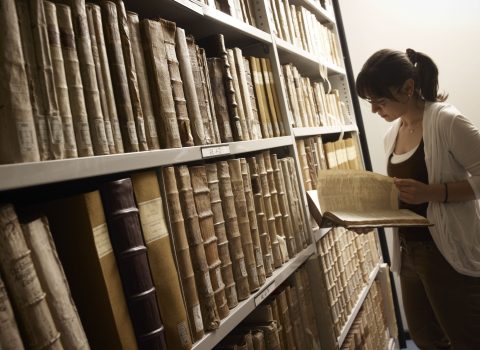
HOLYLAB: a global economic organization in the early modern age. The Franciscan custody of the Holy Land through its accounting records.
FBK's Italian-German Historical Institute is a partner in the ERC project Holylab - A global economic organization in the early modern period: The Custody of the Holy Land through its account books (1600-1800). Felicita Tramontana, principal investigator of the project, tells us about it.
Holylab aims to study the rich archives of the Franciscan Custody of the Holy Land, a global organization that, thanks to a complex system of alms collection, ensured over the centuries the maintenance of the Holy Sepulchre and the presence of friars in the Holy Land. Felicita Tramontana tells FBK Magazine about ideas, issues and problems related to her fascinating “work in progress.”
1. What is the origin of the project?
The project originates from an exciting discovery I made in the archive of Propaganda Fide in the Vatican. While working on a Marie Skłodowska–Curie project on geographical mobility, I came across a volume containing 17th– and 18th-century accounting documents from the Commissariats of the Franciscan Custody of the Holy Land (est. 1342). Studied very little up to now, the commissariats are fund-raising institutions located in various Franciscan provinces. Today like in the past, they are in charge of collecting and sending to Jerusalem the alms needed for the maintenance of the Holy Sepulchre and of the friars living there. The accounting documents list the commissariats’ incomes and expenditures, mostly on a daily basis. The former are mainly alms collected, bequests and donations. The latter consist of purchases of items and food to be sent to Jerusalem; daily expenses of the commissariats; costs related to the transport of objects – from packaging, to the payment of ships and porters – and people.
Immediately, the documents looked like the perfect material around which to build an ERC project. Since they contain massive amounts of data, a survey and analysis of their content could not be easily conducted by a single researcher but needed the involvement of a dedicated research team. The documents also appeared very promising historical sources. First, crosschecked with another little-studied economic source, the account books of the St. Savior monastery in Jerusalem (the headquarters of the Custody), they would allow us to reconstruct the economic organization that enabled an institution like the Custody to survive across the centuries. Second, the accounting documents provided large amounts of data on various topics, such as the circulation of items and people to and from Jerusalem. Furthermore, the study of the commissariats and of the economic organization of the Custody of the Holy Land intersects with (and contributes to) a large number of topics, such as religious accounting; goods utilization practices; early modern (religious) organizations; networks; and Franciscan economy.
From a more personal point of view, applying for an ERC Consolidator Grant was also a natural development of a research path carried out mostly on external funding (from the Italian MIUR’s FIRB programme and the German DFG, to EU co-funded and funded financing schemes such as the EURIAS and Marie Skłodowska–Curie Fellowship programmes), something that had given me extensive experience in writing and conducting research projects. As for many other researchers, the ERC grant also turned out to be an opportunity to return to Italy, after years spent abroad.
2. What were the challenges you faced when building the team and are facing as a team leader?
The ERC gave me the possibility to build and lead a team of researchers with a diverse set of skills that would extract large amounts of data form the sources, build a database and, most importantly, use the information gathered to conduct in-depth historiographical research.
While building the team, a major challenge is finding researchers that have the skills and competences requested by the project and are good team players. The latter is essential in projects like HOLYLAB, which are made up of interconnected work packages. Italian recruitment policies sometimes make this difficult. The evaluation of candidates is based primarily on their publication record, giving monographs the highest scores. This favors researchers with large publication records over younger ones that have just completed a PhD, even if the latter’s research experience are more in tune with the project’s topic. In my case, another problem was the low number of applications by female researchers, an imbalance that surprised me, yet characterized every call I made so far, jeopardizing the possibility to have a gender-balanced team. Once the team is built, a problem often faced by PIs is that postdoctoral researchers understandably look for more stable jobs, be they in academis or elsewhere, which means that positions might need to be re advertised after one or two years.
As for the second part of your question, leading a research team is a very challenging experience, time-consuming and very rewarding at the same time. Especially for someone like me who has been a post doc for many years, a considerable challenge is being able to balance the needs of the project with those of the postdoctoral researchers who work on it. It means making sure that the project has a positive impact on their careers and, at the same time, that the project’s deadlines are met and the planned outcomes are delivered.
3. Does the project investigate the friars’ daily lives in Jerusalem?
One of the most fascinating aspects of the project is that it uncovers many aspects of the friars’ daily life in Jerusalem through the analysis of St. Savior monastery’s daily expenses as well of the items and food arriving in Jerusalem. For instance, by combining these data we can get a pretty accurate sense of the friars’ diet, what they ate on fasting days and which foods was purchased locally, which foods arrived from abroad and what was produced by the monastery. The sources also shed light on the monastery’s manufacturing activities, such as the items used in the monastery’s “Workshops”: the kitchen, the pharmacy, the carpenter’s workshop, and the library. The analysis of the sources also hints at the friars’ relationship with locals, mostly with the Ottoman authorities but also with those who were employed by the friars or provided them services, such as mail delivery.
4. What are the consequences on the project of the war started on October 7?
ERC proposals always involve a section in which applicants describe potential risks that might affect the project’s implementation. Since part of the sources HOLYLAB relies upon are kept in Israel and Jerusalem (the account books of the Custody of the Holy Land, are preserved in the Historic Archive of the St. Savior monastery, Jerusalem; the records of the Ottoman court of Jerusalem are kept in microfilms at the Jewish National Library, Jerusalem, at the University of Haifa, Israel, and at the Centre for Palestinian Heritage, Abu Dis-Bethany, Palestinian Territories), it goes without saying that when preparing the proposal I considered the political instability of the region as a potential risk. However, the unprecedented gravity of the events that took place on October 7 and unfolded in the following months, as well as the extent of violence, were unexpected.
For a long time, the region has been characterized by relatively short-lived conflicts, which would usually challenge the ability to follow a planned timeline, rather than jeopardize the project implementation itself. Envisioned mitigating measures, therefore, included a project structure designed to be flexible enough and, on a more practical level, budgeting for flexible travel tickets. The events of the last few months, and the fear of a regional expansion of the conflict, have led to a new kind of uncertainty regarding the time when it will be possible to safely resume the archival work in the area. Before the October 7 attack, some research trips had been completed by me and other team members, and a further one had been scheduled for two days after the attack. The trip was cancelled and we hoped that it was just being postponed for a few weeks. Weeks have turned into months and, honestly, I do not know when the local conditions will allow us to spend a few months in the area again. ‘ .
